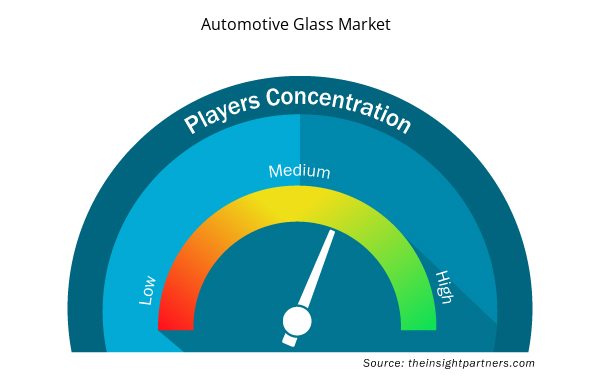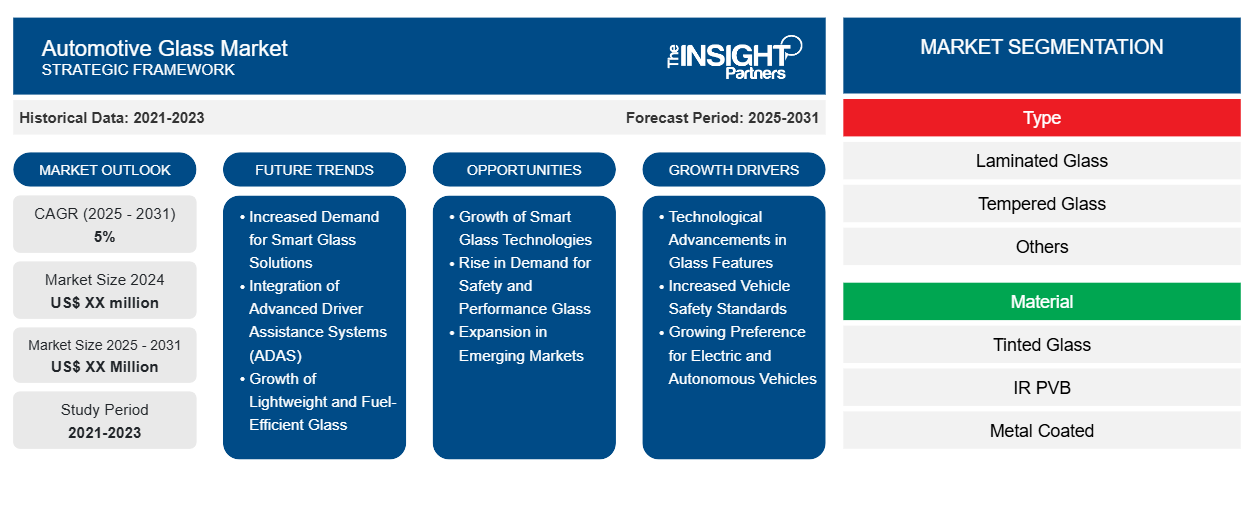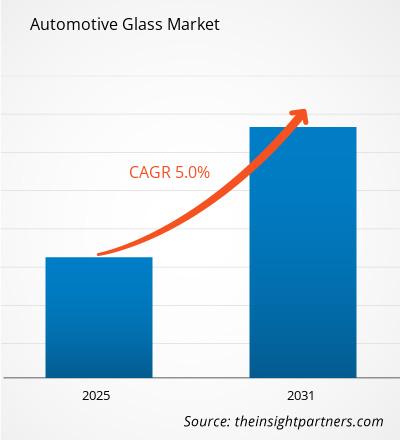Si prevede che il mercato dei vetri per autoveicoli registrerà un CAGR del 5% dal 2023 al 2031, con una dimensione di mercato in espansione da XX milioni di dollari nel 2023 a XX milioni di dollari entro il 2031.
Il report è segmentato per tipo (vetro laminato, vetro temperato, altri). Il report presenta inoltre un'analisi basata su, materiale (vetro colorato, IR PVB, rivestito in metallo, altri). In base al tipo di veicolo, il report è segmentato in (veicoli passeggeri, veicoli commerciali leggeri (LCV), veicoli commerciali pesanti e veicoli a due ruote e altri). L'analisi globale è ulteriormente suddivisa a livello regionale e nei principali paesi. Il report offre il valore in USD per l'analisi e i segmenti di cui sopra.
Scopo del rapporto
Il report Automotive Glass Market di The Insight Partners mira a descrivere il panorama attuale e la crescita futura, i principali fattori trainanti, le sfide e le opportunità. Ciò fornirà spunti a vari stakeholder aziendali, come:
- Fornitori/produttori di tecnologia: per comprendere le dinamiche di mercato in evoluzione e conoscere le potenziali opportunità di crescita, consentendo loro di prendere decisioni strategiche informate.
- Investitori: condurre un'analisi completa delle tendenze in merito al tasso di crescita del mercato, alle proiezioni finanziarie del mercato e alle opportunità esistenti lungo la catena del valore.
- Enti di regolamentazione: regolamentano le politiche e le attività di controllo sul mercato allo scopo di ridurre al minimo gli abusi, preservare la fiducia degli investitori e sostenere l'integrità e la stabilità del mercato.
Segmentazione del mercato dei vetri per auto
Tipo
- Vetro laminato
- Vetro temperato
- Altri
Materiale
- Vetro colorato
- PVB a infrarossi
- Rivestito in metallo
- Altri
Personalizza questo report in base alle tue esigenze
Riceverai la personalizzazione gratuita di qualsiasi report, comprese parti di questo report, o analisi a livello nazionale, pacchetto dati Excel, oltre a usufruire di grandi offerte e sconti per start-up e università
- Scopri le principali tendenze di mercato in questo rapporto.Questo campione GRATUITO includerà analisi di dati che spaziano dalle tendenze di mercato alle stime e alle previsioni.
Fattori trainanti della crescita del mercato dei vetri per auto
- Progressi tecnologici nelle caratteristiche del vetro: il mercato del vetro per auto è guidato da innovazioni come le tecnologie del vetro riscaldato, colorato e intelligente. Queste caratteristiche migliorano il comfort, la sicurezza e l'efficienza energetica. Ad esempio, il vetro elettrocromico, che regola la tinta in risposta alla luce solare, sta diventando sempre più popolare nei veicoli di fascia alta.
- Standard di sicurezza dei veicoli più elevati: con la crescente attenzione al miglioramento della sicurezza dei veicoli, la domanda di vetro laminato e temperato, che offre una migliore resistenza agli urti, è in aumento. I produttori di vetri per auto stanno integrando funzionalità di sicurezza come i sistemi avanzati di assistenza alla guida (ADAS) nei loro prodotti, stimolando ulteriormente la crescita del mercato.
- Crescente preferenza per veicoli elettrici e autonomi: l'aumento dei veicoli elettrici e autonomi sta contribuendo alla domanda di materiali in vetro avanzati. Ad esempio, tetti panoramici, display di realtà aumentata e vetri autoriparanti stanno guadagnando popolarità nei veicoli elettrici e a guida autonoma, determinando la necessità di nuovi tipi di soluzioni in vetro per autoveicoli.
Tendenze future del mercato dei vetri per auto
- Aumento della domanda di soluzioni di vetro intelligenti: si prevede che il mercato dei vetri per auto registrerà una crescita significativa nei prossimi anni con l'adozione di tecnologie di vetro intelligenti. Queste innovazioni includono vetri elettrocromici e fotocromici, che cambiano tinta in risposta ai livelli di luce, migliorando il comfort, la privacy e l'efficienza energetica per gli occupanti del veicolo.
- Integrazione di sistemi avanzati di assistenza alla guida (ADAS): man mano che le tecnologie ADAS diventano più diffuse nei veicoli, i vetri per auto incorporeranno sempre più sensori, telecamere e sistemi di visualizzazione head-up. Questa tendenza porterà a un aumento della domanda di soluzioni di vetri specializzati che si integrino perfettamente con le tecnologie ADAS per migliorare la sicurezza del veicolo e l'esperienza del conducente.
- Crescita di vetro leggero e a basso consumo di carburante: in risposta alla crescente domanda di veicoli a basso consumo energetico, si prevede che aumenterà l'uso di materiali in vetro leggero che contribuiscono alla riduzione complessiva del peso del veicolo. Questi materiali non solo miglioreranno l'efficienza del carburante, ma miglioreranno anche le prestazioni complessive del veicolo e ridurranno le emissioni.
Opportunità di mercato del vetro per auto
- Crescita delle tecnologie Smart Glass: i vetri per auto con tecnologie integrate come l'auto-oscuramento, i sensori touch e gli head-up display offrono significative opportunità di mercato. La crescente adozione di vetri intelligenti, soprattutto nei veicoli di lusso ed elettrici, sta guidando la domanda di soluzioni avanzate per vetri per auto che migliorino il comfort, la sicurezza e l'esperienza di guida complessiva.
- Aumento della domanda di vetri di sicurezza e ad alte prestazioni: con l'aumento degli standard di sicurezza dei veicoli e delle aspettative dei consumatori per una migliore protezione, la domanda di vetri per auto che incorporino caratteristiche quali vetri di sicurezza laminati, vetri infrangibili e protezione UV è in aumento. Ciò offre alle aziende l'opportunità di sviluppare soluzioni di vetri avanzati che soddisfino queste esigenze in continua evoluzione.
- Espansione nei mercati emergenti: il mercato dei vetri per auto è destinato a crescere in modo significativo nelle economie emergenti in cui la produzione e la proprietà dei veicoli sono in aumento. Con il miglioramento delle infrastrutture e l'aumento del reddito disponibile, ci sarà una crescente domanda di vetri per auto di qualità superiore, comprese soluzioni in vetro durevoli ed efficienti dal punto di vista energetico per veicoli di fascia media e premium.
Approfondimenti regionali sul mercato del vetro per auto
Le tendenze regionali e i fattori che influenzano il mercato del vetro per auto durante il periodo di previsione sono stati ampiamente spiegati dagli analisti di Insight Partners. Questa sezione discute anche i segmenti e la geografia del mercato del vetro per auto in Nord America, Europa, Asia Pacifico, Medio Oriente e Africa, e Sud e Centro America.

- Ottieni i dati specifici regionali per il mercato dei vetri per auto
Ambito del rapporto sul mercato del vetro per auto
| Attributo del report | Dettagli |
|---|---|
| Dimensioni del mercato nel 2023 | XX milioni di dollari USA |
| Dimensioni del mercato entro il 2031 | XX milioni di dollari USA |
| CAGR globale (2023-2031) | 5% |
| Dati storici | 2021-2022 |
| Periodo di previsione | 2024-2031 |
| Segmenti coperti | Per tipo
|
| Regioni e Paesi coperti | America del Nord
|
| Leader di mercato e profili aziendali chiave |
|
Densità degli attori del mercato del vetro per auto: comprendere il suo impatto sulle dinamiche aziendali
Il mercato del vetro per autoveicoli sta crescendo rapidamente, spinto dalla crescente domanda degli utenti finali dovuta a fattori quali l'evoluzione delle preferenze dei consumatori, i progressi tecnologici e una maggiore consapevolezza dei vantaggi del prodotto. Con l'aumento della domanda, le aziende stanno ampliando le loro offerte, innovando per soddisfare le esigenze dei consumatori e capitalizzando sulle tendenze emergenti, il che alimenta ulteriormente la crescita del mercato.
La densità degli operatori di mercato si riferisce alla distribuzione di aziende o società che operano in un particolare mercato o settore. Indica quanti concorrenti (operatori di mercato) sono presenti in un dato spazio di mercato in relazione alle sue dimensioni o al valore di mercato totale.
Le principali aziende che operano nel mercato dei vetri per auto sono:
- AGC Inc
- Corning Incorporata
- Gruppo industriale del vetro Fuyao Co. Ltd
- Società Gentex
- Industrie Guardian
Disclaimer : le aziende elencate sopra non sono classificate secondo un ordine particolare.

- Ottieni una panoramica dei principali attori del mercato dei vetri per auto
Punti di forza chiave
- Copertura completa: il rapporto esamina in modo completo i prodotti, i servizi, le tipologie e gli utenti finali del mercato dei vetri per autoveicoli, offrendo una panoramica olistica.
- Analisi degli esperti: il rapporto è compilato sulla base della conoscenza approfondita di esperti e analisti del settore.
- Informazioni aggiornate: il rapporto garantisce la pertinenza aziendale grazie alla copertura di informazioni recenti e tendenze nei dati.
- Opzioni di personalizzazione: questo report può essere personalizzato per soddisfare le esigenze specifiche del cliente e adattarsi in modo appropriato alle strategie aziendali.
Il rapporto di ricerca sul mercato del vetro per autoveicoli può quindi aiutare a guidare il percorso di decodifica e comprensione dello scenario del settore e delle prospettive di crescita. Sebbene possano esserci alcune preoccupazioni valide, i vantaggi complessivi di questo rapporto tendono a superare gli svantaggi.
- Analisi storica (2 anni), anno base, previsione (7 anni) con CAGR
- Analisi PEST e SWOT
- Valore/volume delle dimensioni del mercato - Globale, regionale, nazionale
- Industria e panorama competitivo
- Set di dati Excel


- Advanced Planning and Scheduling Software Market
- Electronic Toll Collection System Market
- Semiconductor Metrology and Inspection Market
- Volumetric Video Market
- Electronic Data Interchange Market
- Thermal Energy Storage Market
- 3D Mapping and Modelling Market
- Cut Flowers Market
- Influenza Vaccines Market
- Environmental Consulting Service Market

Report Coverage
Revenue forecast, Company Analysis, Industry landscape, Growth factors, and Trends

Segment Covered
This text is related
to segments covered.

Regional Scope
North America, Europe, Asia Pacific, Middle East & Africa, South & Central America

Country Scope
This text is related
to country scope.
Domande frequenti
Based on geography, Asia Pacific held the largest share of the automotive glass market due to the well-established automotive industry across the region
Increased demand for smart glass solutions is expected to be the key market trends.
Based on type, tempered glass segment is expected to witness the fastest growth during the forecast period
The Automotive Glass Market is estimated to witness a CAGR of 5% from 2023 to 2031
Technological advancements in glass features is driving the automotive glass market growth.
AGC Inc, Corning Incorporated, Fuyao Glass Industry Group Co. Ltd, Gentex Corporation, Guardian Industries, Nippon Sheet Glass Co., Ltd are some of the key players operating in the automotive glass market
Trends and growth analysis reports related to Chemicals and Materials : READ MORE..
The List of Companies
1.AGC Inc
2.Corning Incorporated
3.Fuyao Glass Industry Group Co. Ltd
4.Gentex Corporation
5.Guardian Industries
6.Nippon Sheet Glass Co., Ltd
7.Saint-Gobain Sekurit
8.Sisecam Group
9.Vitro SAB de CV
10.Xinyi Glass Holdings Ltd.
The Insight Partners performs research in 4 major stages: Data Collection & Secondary Research, Primary Research, Data Analysis and Data Triangulation & Final Review.
- Data Collection and Secondary Research:
As a market research and consulting firm operating from a decade, we have published and advised several client across the globe. First step for any study will start with an assessment of currently available data and insights from existing reports. Further, historical and current market information is collected from Investor Presentations, Annual Reports, SEC Filings, etc., and other information related to company’s performance and market positioning are gathered from Paid Databases (Factiva, Hoovers, and Reuters) and various other publications available in public domain.
Several associations trade associates, technical forums, institutes, societies and organization are accessed to gain technical as well as market related insights through their publications such as research papers, blogs and press releases related to the studies are referred to get cues about the market. Further, white papers, journals, magazines, and other news articles published in last 3 years are scrutinized and analyzed to understand the current market trends.
- Primary Research:
The primarily interview analysis comprise of data obtained from industry participants interview and answers to survey questions gathered by in-house primary team.
For primary research, interviews are conducted with industry experts/CEOs/Marketing Managers/VPs/Subject Matter Experts from both demand and supply side to get a 360-degree view of the market. The primary team conducts several interviews based on the complexity of the markets to understand the various market trends and dynamics which makes research more credible and precise.
A typical research interview fulfils the following functions:
- Provides first-hand information on the market size, market trends, growth trends, competitive landscape, and outlook
- Validates and strengthens in-house secondary research findings
- Develops the analysis team’s expertise and market understanding
Primary research involves email interactions and telephone interviews for each market, category, segment, and sub-segment across geographies. The participants who typically take part in such a process include, but are not limited to:
- Industry participants: VPs, business development managers, market intelligence managers and national sales managers
- Outside experts: Valuation experts, research analysts and key opinion leaders specializing in the electronics and semiconductor industry.
Below is the breakup of our primary respondents by company, designation, and region:

Once we receive the confirmation from primary research sources or primary respondents, we finalize the base year market estimation and forecast the data as per the macroeconomic and microeconomic factors assessed during data collection.
- Data Analysis:
Once data is validated through both secondary as well as primary respondents, we finalize the market estimations by hypothesis formulation and factor analysis at regional and country level.
- Macro-Economic Factor Analysis:
We analyse macroeconomic indicators such the gross domestic product (GDP), increase in the demand for goods and services across industries, technological advancement, regional economic growth, governmental policies, the influence of COVID-19, PEST analysis, and other aspects. This analysis aids in setting benchmarks for various nations/regions and approximating market splits. Additionally, the general trend of the aforementioned components aid in determining the market's development possibilities.
- Country Level Data:
Various factors that are especially aligned to the country are taken into account to determine the market size for a certain area and country, including the presence of vendors, such as headquarters and offices, the country's GDP, demand patterns, and industry growth. To comprehend the market dynamics for the nation, a number of growth variables, inhibitors, application areas, and current market trends are researched. The aforementioned elements aid in determining the country's overall market's growth potential.
- Company Profile:
The “Table of Contents” is formulated by listing and analyzing more than 25 - 30 companies operating in the market ecosystem across geographies. However, we profile only 10 companies as a standard practice in our syndicate reports. These 10 companies comprise leading, emerging, and regional players. Nonetheless, our analysis is not restricted to the 10 listed companies, we also analyze other companies present in the market to develop a holistic view and understand the prevailing trends. The “Company Profiles” section in the report covers key facts, business description, products & services, financial information, SWOT analysis, and key developments. The financial information presented is extracted from the annual reports and official documents of the publicly listed companies. Upon collecting the information for the sections of respective companies, we verify them via various primary sources and then compile the data in respective company profiles. The company level information helps us in deriving the base number as well as in forecasting the market size.
- Developing Base Number:
Aggregation of sales statistics (2020-2022) and macro-economic factor, and other secondary and primary research insights are utilized to arrive at base number and related market shares for 2022. The data gaps are identified in this step and relevant market data is analyzed, collected from paid primary interviews or databases. On finalizing the base year market size, forecasts are developed on the basis of macro-economic, industry and market growth factors and company level analysis.
- Data Triangulation and Final Review:
The market findings and base year market size calculations are validated from supply as well as demand side. Demand side validations are based on macro-economic factor analysis and benchmarks for respective regions and countries. In case of supply side validations, revenues of major companies are estimated (in case not available) based on industry benchmark, approximate number of employees, product portfolio, and primary interviews revenues are gathered. Further revenue from target product/service segment is assessed to avoid overshooting of market statistics. In case of heavy deviations between supply and demand side values, all thes steps are repeated to achieve synchronization.
We follow an iterative model, wherein we share our research findings with Subject Matter Experts (SME’s) and Key Opinion Leaders (KOLs) until consensus view of the market is not formulated – this model negates any drastic deviation in the opinions of experts. Only validated and universally acceptable research findings are quoted in our reports.
We have important check points that we use to validate our research findings – which we call – data triangulation, where we validate the information, we generate from secondary sources with primary interviews and then we re-validate with our internal data bases and Subject matter experts. This comprehensive model enables us to deliver high quality, reliable data in shortest possible time.


 Ottieni un campione gratuito per questo repot
Ottieni un campione gratuito per questo repot